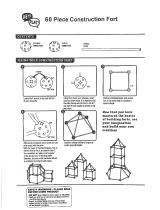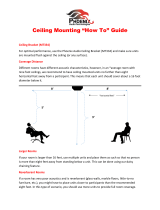
Community R-Series Application Guide — Page 8
Custom Mounting Brackets
Custom brackets, made of corrosion-resistant, properly-rated steel may be used. When mounting the loudspeaker the bracket
should pull directly either in tension or shear on the mounting bolt. It is recommended that any custom bracket utilize two
mounting points on the opposite sides or top and bottom of the enclosure.
Mounting an R6-51 or R6-Basshorn
Mounting systems for large loudspeakers, like the R6-51 and R6-Basshorn, vary widely depending on the needs of the
facility. For this reason, Community does not supply a yoke, fasteners or any other mounting hardware with the R6-51 or
R6-Basshorn. The installing contractor must supply all such hardware and must design a secure mounting system for the
loudspeaker. Always use properly-rated, corrosion-resistant fasteners of an appropriate length, secured with washers, lock
washers and Locktite or other fastener-locking method. The overall mounting system must be approved by a licensed
P.E. (USA) or other certification professional (outside USA) before installation.
The R6-51 and R6-Basshorn have four primary mounting points, with ½” x 13-TPI stainless steel inserts, suitable for
suspension of the loudspeaker. Two are located on the back of the loudspeaker. One is on the top and one is on the
bottom. The R6-51 and R6-Basshorn also have 10 holes in the front enclosure flange which are not designed for primary
suspension usage or for safety-cable attachment. However, these front mounting holes may be used as supplemental mounting
points for support of the front of the loudspeaker. Note that, on the R6-51, there are three bolts on the top and the bottom
of the enclosure used to fasten the mid-high pack to the inside of the loudspeaker. These bolts are not suitable for suspension
or for safety-cable attachment.
For many applications, the top and bottom mounting points, used together, are sufficient for secure mounting of these
loudspeakers. When a safety-cable mounting point is required, one or both of the rear mounting points may be used. In
applications where the loudspeaker may be subjected to high wind loads or other unusual stresses, Community recommends
the loudspeaker be mounted from the top and bottom and at least one of the rear mounting points with the remaining rear
mounting point available for a safety cable. For additional support in these applications, design the mounting structure to
utilize the front mounting points as supplemental support. When possible, use all three mounting systems (top/bottom, rear,
front). When in doubt, consult with the same licensed P.E. or other certification professional who will approve the design.
Orienting an R-Series Loudspeaker
An R-Series loudspeaker has a definite top, bottom and sides. However, a 180 degree inversion will not affect the coverage.
When the top of the enclosure is up, the input cable gland-nut will be down and to your right when looking directly at the
front of the loudspeaker. Also, the manufacturer's label is on the top of the enclosure. Once the top is determined, you can
properly orient the loudspeaker for your particular application according to the specified coverage pattern. When installed
outdoors, Community recommends tilting an R-Series loudspeaker downwards at least 15° to allow water to drain from the
enclosure.
R-Series Throw Distance and Sound Levels
The chart on Page 11 helps answer the question, “how far can it throw?”. The chart shows the maximum distance at which a
given model can reach 96 dB SPL on the A Scale (speech range). Consider a high-school football stadium where the crowd
noise is 86 dBA. At the recommended distance, an R.25 or R.5 would provide 10 dB headroom above the crowd noise. Even
if the crowd noise reaches 90 dBA, the R.25 or R.5 would still provide 6 dB of headroom which is acceptable for voice paging
and announcement systems (use a limiter to avoid clipping).
In larger facilities, crowd noise can exceed 100 dBA. At motor racing events, racing noise can exceed 120 dBA near the track.
It is impractical and unsafe to try to page above these levels. It’s better to train announcers to wait till the crowd (or motor
noise) quiets down and to repeat the page.
Additional Notes on Weather-Resistance
• No loudspeaker is completely “weather proof”. However, Community R-Series loudspeakers are designed to withstand
continuous outdoor exposure for many years of operation.
• We recommend angling the R-Series loudspeaker at least 15 degrees downward so as to reduce the possibility
of rain and other precipitation compromising the performance of the loudspeaker.
• All mounting holes must be sealed off with the supplied bolts, washers, and rubber washers. If, for any reason, these bolts
must be removed, seal off the hole with silicone caulking or some other suitable weather-tight sealant. The rubber
washers supplied with the mounting bolts must always seat against the enclosure.
• The gland nut securing the loudspeaker cable to the enclosure is sealed at the factory. Do not attempt to remove this nut
or the weather-tight seal will be broken. If it is desired to replace the gland nut with a connector, the connector must be a
INSTALLATION





















